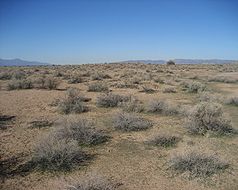Hohokam Pima National Monument
| Hohokam Pima National Monument | ||
|---|---|---|
| The plain of the Gila River, the ruins are almost completely covered | ||
|
|
||
| Location: | Arizona , United States | |
| Specialty: | Traces of settlement of the Hohokam Indians | |
| Next city: | Chandler | |
| Surface: | 6.8 km² | |
| Founding: | October 21, 1972 | |
| Visitors: | not open to the public | |
Hohokam Pima National Monument is a small protected area of the type of a national monument in the south of the US state Arizona . Under the administration of the National Park Service, it preserves a prehistoric settlement of Indians of the Hohokam culture known today as Snaketown .
The area is located in Pinal County , southwest of Chandler , entirely within the Gila River Reservation of the Pima Indians and is not open to the public. Since 1990 the area has been on the list of proposals for recognition as a World Heritage Site by Unesco .
The settlement
The Hohokam Indians settled central and southern Arizona from around 2100 BC. BC to approx. 1500. They were arable farmers and cultivated cotton and tobacco as well as the three main crops maize , beans and squash squash on the dry soil of the semi-desert . To irrigate their fields, the Hohokam built canals from the Gila River .
The settlement in the valley of the Gila River, now called Snaketown , was built around 300 BC. Founded and abandoned around 1100. The settlement consisted of pit houses , the walls of which were made of wickerwork and adobe mud bricks . Over 60 fireplaces can be proven, the number should roughly correspond to the number of buildings. They were grouped around a central square. The settlement included two oval areas that were traditionally identified with fields for the Mesoamerican ball game . In 2009, however, it was suggested that these are dance floors from which the traditions of the Papago's Vikita festival , which existed well into the 20th century, emerged. The curved side lines and the low borders, as well as other features, make the courts of the Hohokam unsuitable for ball games, but correspond to the shapes of the Papago.
A variety of ceramic vessels were found in the area, as well as jewelry made from mussel shells . The most elaborate objects of the excavation include 52 stone slabs, which were covered with a thin layer of pyrite . The objects belong to a genus that is widespread in Central America , but in today's USA is only known from southern Arizona and a site in New Mexico . They are interpreted as mirrors and can be called pyrite-encrusted mirrors in English and espejos de pirita in Spanish . The stone slabs were covered with an adhesive made of resins with thin, very precisely cut layers of iron disulfide in the form of pyrite. The layer was made up of between an exceptionally large piece and up to 40 or 50 individual elements. Despite the hardness of the material, they were made to fit exactly, which is particularly remarkable because the individual parts were polygons that never had less than four and up to nine sides. These mirrors were only partially used as instruments in the hand, traces of drillings show that they were attached to clothing or incorporated into headgear.
Bells and small figures made of copper were not made on site, but traded from Central America .
The settlement was excavated in 1934 by the Gila Pueblo Archaeological Foundation under the direction of Harold S. Gladwin. From 1964 to 1965 a second investigation took place under Emil Haury. The excavations were completely backfilled after completion. No buildings or other traces can be seen on the surface. Artifacts from the settlement are on display in several museums in Phoenix and the nearby Casa Grande Ruins National Monument .
On April 29, 1964, the Snaketown prehistoric settlement was recognized as a National Historic Landmark . The National Monument was added to the National Register of Historic Places on July 19, 1974 .
Web links
- National Park Service: Hohokam Pima National Monument (official site; English)
- UNESCO: Hohokam Pima National Monument on the World Heritage Site Proposal List
- Poster presentation about the irrigation canals of the Snaketown settlement
Individual evidence
- ^ Edwin N. Ferdon, jr .: The Hohokam 'Ball Court' - An Alternative View of its Function . In: KIVA , Vol 75, No. 2, Winter 2009, ISSN 0023-1940 , pp. 165-178
- ↑ Emiliano Gallaga: Pyrite encrusted MIRRORS AND THEIR AT Snaketown EXTERNAL RELATIONSHIPS TO mesoamerica . In: Kiva, Vol. 79 (2014), Issue 3, pp. 280–299 doi: 10.1179 / 0023194014Z.00000000025
- ↑ Listing of National Historic Landmarks by State: Arizona. National Park Service , accessed July 20, 2019.
- ↑ Hohokam-Pima National Monument in the National Register Information System. National Park Service , accessed July 29, 2017.

